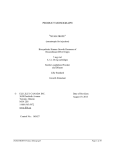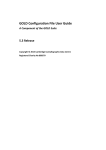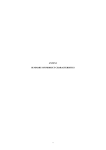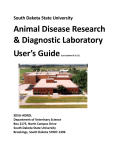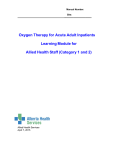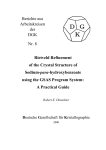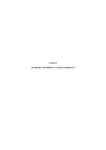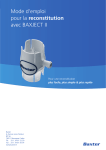Download RIXUBIS - Recombinant Coagulation Factor IX (rFIX)
Transcript
PRODUCT MONOGRAPH
RIXUBIS
Recombinant Coagulation Factor IX (rFIX), Nonacog gamma
Lyophilized Powder, 250, 500, 1000, 2000 and 3000 International Units (IU) per vial
Coagulant
Manufactured by:
Baxalta U.S. Inc.
Westlake Village, CA
91362
USA
Submission Control No: 183079
Imported and Distributed by:
Baxalta Canada Corporation
7125 Mississauga Road
Mississauga, ON
Canada L5N 0C2
Date of Revision:
June 04, 2015
Date of Approval : Jun 05, 2015
RIXUBIS (Recombinant Coagulation Factor IX (rFIX), Nonacog gamma)
Page 1 of 30
Table of Contents
PART I: HEALTH PROFESSIONAL INFORMATION ........................................................ 3
SUMMARY PRODUCT INFORMATION ....................................................................... 3
DESCRIPTION................................................................................................................... 3
INDICATIONS AND CLINICAL USE ............................................................................. 3
CONTRAINDICATIONS .................................................................................................. 4
WARNINGS AND PRECAUTIONS ................................................................................. 4
ADVERSE REACTIONS................................................................................................... 6
DRUG INTERACTIONS ................................................................................................... 9
DOSAGE AND ADMINISTRATION ............................................................................... 9
OVERDOSAGE ............................................................................................................... 15
ACTION AND CLINICAL PHARMACOLOGY ........................................................... 15
STORAGE AND STABILITY ......................................................................................... 17
SPECIAL HANDLING INSTRUCTIONS ...................................................................... 17
DOSAGE FORMS, COMPOSITION AND PACKAGING ............................................ 18
PART II: SCIENTIFIC INFORMATION .............................................................................. 19
PHARMACEUTICAL INFORMATION......................................................................... 19
CLINICAL TRIALS ......................................................................................................... 21
DETAILED PHARMACOLOGY .................................................................................... 24
MICROBIOLOGY ........................................................................................................... 24
TOXICOLOGY ................................................................................................................ 25
REFERENCES ................................................................................................................. 25
PART III: CONSUMER INFORMATION............................................................................. 26
RIXUBIS (Recombinant Coagulation Factor IX (rFIX), Nonacog gamma)
Page 2 of 30
RIXUBIS
Recombinant Coagulation Factor IX (rFIX), Nonacog gamma
PART I: HEALTH PROFESSIONAL INFORMATION
SUMMARY PRODUCT INFORMATION
Route of
Administration
Dosage Form /
Strength
Intravenous Injection Lyophilized Powder
for Intravenous
injection / 250, 500,
1000, 2000, 3000
International Units
(IU) per vial
reconstituted with 5
mL of water for
injection
Clinically Relevant Nonmedicinal
Ingredients
For a complete listing see Dosage Forms,
Composition and Packaging section.
DESCRIPTION
RIXUBIS [Recombinant Coagulation Factor IX (rFIX)] is a glycoprotein consisting of 415
amino acids. RIXUBIS is synthesized by a genetically engineered Chinese hamster ovary (CHO)
cell line. No (exogenous) materials of human or animal origin are employed in the manufacture,
purification, or formulation of the final product. The growth medium is chemically defined and
the downstream process does not use monoclonal antibodies for the purification of RIXUBIS.
The production process also includes two, independent viral removal/inactivation steps:
solvent/detergent treatment and nanofiltration.
Biological potency is determined by a one-stage clotting assay, which employs a factor IX
concentrate standard that is referenced to the World Health Organization (WHO) Internal
Standard for factor IX concentrates.
INDICATIONS AND CLINICAL USE
RIXUBIS is indicated in adult patients with hemophilia B (congenital factor IX deficiency or
Christmas disease) for:
• Control of bleeding episodes
RIXUBIS (Recombinant Coagulation Factor IX (rFIX), Nonacog gamma)
Page 3 of 30
•
•
Perioperative management
Routine prophylaxis to prevent or reduce the frequency of bleeding episodes
Geriatrics (> 65 years of age):
Clinical studies of RIXUBIS did not include subjects aged 65 years and over. It is not known
whether they respond differently from younger subjects. As for all patients, dose selection for an
elderly patient should be individualized.
Pediatrics (< 12 years of age):
Safety and efficacy of RIXUBIS in patients less than 12 years have not been established.
CONTRAINDICATIONS
RIXUBIS contains trace amounts of Chinese Hamster ovary cell line (CHO). RIXUBIS is
contraindicated in patients with known hypersensitivity to active substance, to excipients, or to
hamster protein.
WARNINGS AND PRECAUTIONS
General
Anaphylaxis and other hypersensitivity reactions have been reported with factor IX-containing
products. Patients and/or their caregivers should be informed of the early signs of
hypersensitivity reactions. They should be advised to discontinue use of the product immediately
and contact their physician if such symptoms occur. The risk is highest during the early phases of
initial exposure to factor IX concentrates in previously untreated patients (PUPs), in particular in
patients with high risk gene mutations. Early signs of anaphylaxis or allergic reactions include
angioedema, chest-tightness, hypotension, lethargy, nausea, vomiting, paresthesia, restlessness,
wheezing, and dyspnea.
In some cases, these reactions have progressed to severe anaphylaxis. In the case of shock, the
current medical standards for treatment of shock should be observed. In case of severe allergic
reactions, alternative hemostatic measures should be considered. Discontinue administration and
initiate appropriate treatment if allergic or anaphylactic-type reactions occur.
There have been reports in the literature showing an association between the occurrence of a
factor IX inhibitor and allergic reactions. Therefore, patients experiencing allergic reactions
should be evaluated for the presence of an inhibitor.
RIXUBIS (Recombinant Coagulation Factor IX (rFIX), Nonacog gamma)
Page 4 of 30
RIXUBIS contains trace amounts of hamster (CHO) proteins. Patients treated with this product
may develop hypersensitivity to these non-human mammalian proteins.
Other factor IX products have had post-marketing reports of thrombotic events in patients
receiving continuous-infusion through a central venous catheter, including life-threatening
superior vena cava (SVC) syndrome in critically ill neonates.
Inhibitors
Patients with hemophilia B may develop neutralizing antibodies (inhibitors) to factor IX. Patients
using RIXUBIS should be regularly evaluated for the development of factor IX inhibitors by
appropriate clinical observations and laboratory tests. If expected plasma factor IX activity levels
are not attained, or if bleeding is not controlled with an expected dose, an assay that measures
factor IX inhibitor concentration should be performed.
If a patient develops an inhibitor, it is recommended that a specialized hemophilia center be
contacted.
In patients with high titer factor IX inhibitors, RIXUBIS therapy may not be effective and other
therapeutic options should be considered.
Patients with factor IX inhibitors are at an increased risk of severe hypersensitivity reactions or
anaphylaxis if re-exposed to factor IX.
Nephrotic Syndrome
Nephrotic syndrome has been reported following attempted immune tolerance induction in
hemophilia B patients with factor IX inhibitors. The safety and efficacy of using RIXUBIS for
immune tolerance induction has not been established.
Thromboembolic Complications
The use of factor IX products has been associated with the development of thromboembolic
complications (e.g., pulmonary embolism, venous thrombosis, arterial thrombosis, cerebral
artery thrombosis, superior vena cava obstruction). Factor IX-containing products may be
potentially hazardous in patients with disseminated intravascular coagulation (DIC) and in
patients with signs of fibrinolysis.
Clinical surveillance for early signs of thrombotic and consumptive coagulopathy should be
initiated with appropriate biological testing, in particular when administering RIXUBIS to
RIXUBIS (Recombinant Coagulation Factor IX (rFIX), Nonacog gamma)
Page 5 of 30
patients with liver disease, to patients peri- and post-operatively, to new born infants or to
patients at risk for thrombotic events or DIC.
In patients with DIC or those at risk for DIC or thromboembolic events, the benefit of treatment
with RIXUBIS should be weighed against the risk of these complications.
Special Populations
Pregnancy, Lactation and Fertility: There are no data from the use of RIXUBIS in pregnant or
lactating women. Healthcare providers should balance the potential risks and only prescribe
RIXUBIS if clearly needed. There is no information on the effects of RIXUBIS on fertility.
Pediatrics: There are insufficient data to recommend the use of RIXUBIS in children less than
12 years of age.
Geriatrics (> 65 years of age): Clinical studies of RIXUBIS did not include subjects aged 65
years and over. It is not known whether they respond differently from younger subjects. Dose
selection for an elderly patient should be individualized. See Dosage and Administration.
Monitoring and Laboratory Tests
Monitor factor IX activity levels by using an appropriate factor IX activity assay, eg. the onestage clotting assay, to confirm that adequate factor IX levels have been achieved and
maintained, when clinically indicated [see Dosage and Administration]. If necessary, appropriate
adjustments to the dose and the frequency of repeated infusions should be performed.
Monitor for the development of inhibitors if expected factor IX activity plasma levels are not
attained, or if bleeding is not controlled with the recommended dose of RIXUBIS. Assays used
to determine factor IX inhibitors if present should be titred in Bethesda units.
ADVERSE REACTIONS
Adverse Drug Reaction Overview
The most common adverse reactions observed in >1% of subjects of RIXUBIS clinical trials
were a positive Furin antibody test, dysgeusia and pain in extremity. See Table 1 for Summary
of Adverse Reactions.
Clinical Trial Adverse Drug Reactions
RIXUBIS (Recombinant Coagulation Factor IX (rFIX), Nonacog gamma)
Page 6 of 30
Because clinical trials are conducted under very specific conditions the adverse reaction
rates observed in the clinical trials may not reflect the rates observed in practice and
should not be compared to the rates in the clinical trials of another drug. Adverse drug
reaction information from clinical trials is useful for identifying drug-related adverse
events and for approximating rates.
During clinical development in a combined trial, 91 unique previously treated patients (PTPs;
exposed to a factor IX concentrate on ≥ 150 days) received at least 1 infusion of RIXUBIS for
either on-demand treatment of bleeding episodes, in the perioperative management of major and
minor surgical, dental, or other invasive procedures, for routine prophylaxis, or for the evaluation
of the pharmacokinetics of RIXUBIS. Six subjects (6.6%) were <6 years of age, 10 (11.0%)
were 6 to <12 years of age, 3 (3.3%) were adolescents (12 to <16 years of age), and 72 (79.1%)
were adults (16 years of age and older). Ninety-one treated subjects received a total of 7,353
infusions with a median of 85 infusions of RIXUBIS (range 3 to 212 infusions) and for a median
of 83 exposure days (range 83 to 209 days)
A total of 161 adverse events were reported in 48 (52.7%) of the 91 subjects.
Adverse reactions that occurred in >1% of subjects are shown in Table 1.
Table 1.
Summary of Adverse Reactions
Nervous System Disorders
Dysgeusia
2
Number of
Subjects
N = 91
n (%)
1 (1.1%)
Musculoskeletal and
Connective Tissue Disorders
Pain in extremity
1
1 (1.1%)
0.01%
Investigations
Furin antibody test positive*
1
1 (1.1%)
0.01%
System Organ Class (SOC)
Events
Number
of ARs
(n)
Percent
per
Infusion
N=7353
0.03%
* See Immunogenicity
RIXUBIS (Recombinant Coagulation Factor IX (rFIX), Nonacog gamma)
Page 7 of 30
Immunogenicity
All 91 subjects were monitored for inhibitory and binding antibodies to factor IX, and binding
antibodies to CHO protein and furin, at the following time points: at screening, at 72 hours
following the first infusion of RIXUBIS and the commercial recombinant factor IX product in
the crossover portion of the pharmacokinetic study, after 5 and 13 weeks following first exposure
to RIXUBIS, and thereafter every 3 months. Antibodies against furin were tested by an in-house
enzyme-linked immunosorbent assay (ELISA). A titer of 1:20 or 1:40 was considered to be
indeterminate for the above validated assay, as these titers were too low to be verified by the
confirmatory assay.
No subjects developed neutralizing antibodies to factor IX. Thirteen subjects (14.3%) developed
low-titer, non-neutralizing antibodies against factor IX at one or more time points. Two of these
13 subjects were found to have these antibodies at screening, prior to receiving RIXUBIS. No
clinical adverse findings were observed in any of these 13 subjects.
Thirteen subjects (14.3%) had signals for antibodies against furin (indeterminate specificity).
Four of these 13 subjects expressed signals for antibodies at screening, prior to RIXUBIS
treatment. An additional subject had an antibody signal after treatment with the comparator
product and prior to RIXUBIS treatment. Another additional subject had a positive titer of 1:80
that was not present when checked at a later time point and therefore considered transient. A
second subject had a positive antibody signal after the data cutoff date that was also transient.
No clinical adverse findings were observed in any of these 15 subjects.
In a study of 500 normal volunteers, using the same assay as in the clinical trial, 7% had titers of
1:20 or 1:40 and 1.2% had higher titers ranging from 1:80 to 1:320. These antibodies are
thought to be part of a natural immune system response. To date, these antibodies have not been
associated with any clinical adverse findings.
The detection of antibody formation is highly dependent on the sensitivity and specificity of the
assay. Additionally, the observed incidence of antibody (including neutralizing antibody)
positivity in an assay may be influenced by several factors, including assay methodology, sample
handling, timing of sample collection, concomitant medications, and underlying disease.
Post-Market Adverse Drug Reactions
Immune System Disorders: Hypersensitivity (including symptoms such as dyspnea, pruritus)
Skin and Subcutaneous Tissue Disorders: Urticaria, rash
The following class adverse reactions have been seen with another recombinant factor IX:
inadequate factor IX recovery, inhibitor development, anaphylaxis, angioedema, hypotension,
and thrombosis.
RIXUBIS (Recombinant Coagulation Factor IX (rFIX), Nonacog gamma)
Page 8 of 30
DRUG INTERACTIONS
Drug-Drug Interactions
No interactions of recombinant coagulation factor IX products with other medicinal products are
known.
DOSAGE AND ADMINISTRATION
General
Treatment should be initiated under the supervision of a physician experienced in the treatment
of hemophilia. The safety and efficacy of RIXUBIS administration by continuous infusion has
not been established.
The dosage and duration of the replacement therapy depend on the severity of factor IX
deficiency, the location and extent of bleeding, and the patients clinical condition, age and
pharmacokinetic parameters of factor IX, such as incremental recovery and half-life.
Monitor patients using an appropriate factor IX activity assay to ensure that the desired factor IX
activity plasma has been attained. If necessary, adjust the dose and the frequency of repeated
infusions as appropriate. Careful monitoring of replacement therapy is especially important in
cases of major surgery or life-threatening hemorrhages.
Evaluate the patient for the development of factor IX inhibitors if the expected factor IX activity
plasma levels are not attained or if bleeding is not controlled with an appropriate dose. [see
Warnings and Precautions]
Each vial of RIXUBIS has the factor IX (rFIX) potency in international units stated on the vial
Dosing of RIXUBIS may differ from that of plasma-derived factor IX products [see Clinical
Pharmacology]. Subjects at the low end of the observed factor IX recovery may require dose
adjustment of RIXUBIS.
FIX potency results can be affected by the type of aPTT reagent and reference standard used in
the assay; differences of up to 40% have been observed.
Recommended Dose and Dosage Adjustment
Method for Calculating Initial Estimated Dose
A guide for calculating the dose for treatment of bleeding episodes is provided in Table 2.
RIXUBIS (Recombinant Coagulation Factor IX (rFIX), Nonacog gamma)
Page 9 of 30
Table 2.
Method for Calculating Initial Estimated Dose
Number of factor
IX International
Units required
(IU)
=
Body Weight
(kg)
x
Desired factor
IX increase
(% or IU/dL)
x
Reciprocal
of Observed
recovery
(IU/kg per IU/dL)
The calculation of the required dose of RIXUBIS is based on the empirical finding that one
international unit of RIXUBIS per kg body weight is expected to increase the circulating level of
factor IX by 0.9 IU/dL of plasma (0.9% of normal) (range from 0.5 to 1.4 IU/dL) in patients 12
years and older.
Incremental Recovery in Previously Treated Patients (PTPs)
For an incremental recovery of 0.9 IU/dL of plasma (0.9% of normal), the dose is calculated as
follows:
Table 3.
Calculating Incremental Dose Adjustment
Number of factor IX
International Units
required
(IU)
=
Body Weight
(kg)
x
Desired factor
IX increase
(% or IU/dL)
x
1.1 dL/kg
It is recommended to base the calculation of the required dose on the patient’s individual
incremental recovery using serial factor IX activity assays due to the wide range of interindividual differences in incremental recovery. Titrate the dose based on the patient's clinical
response and individual pharmacokinetics, in particular incremental recovery and half-life.
Examples (assuming patient’s baseline factor IX level is <1% of normal):
1. A dose of 4550 IU RIXUBIS administered to a 70 kg patient should be expected to result in a
peak post-infusion factor IX increase of 4550 IU x {[0.9 IU/dL]/[IU/kg]}/[70 kg] = 59 IU/dL
(59% of normal).
RIXUBIS (Recombinant Coagulation Factor IX (rFIX), Nonacog gamma)
Page 10 of 30
2. A peak level of 70% is required in a 60 kg patient. In this situation, the appropriate dose
would be 60 kg x 70 IU/dL/{[0.9 IU/dL]/[IU/kg]} = 4667 IU.
Treatment of Bleeding Episodes and Perioperative Management
A guide for dosing in the treatment of bleeding episodes and perioperative management is
provided in Table 4 and Table 5, respectively. Ensure the factor IX activity level is achieved and
maintained in the corresponding period.
Table 4.
RIXUBIS Dosing for Control and Prevention of Bleeding Episodes
Type of Bleeding
Episodes
Circulating
factor IX level
Required
(% or IU/dL)
Dosing
Interval
(hours)
Duration of Therapy
20-30
12-24
Treat until bleeding stops
and healing begins about 1-2
days
Minor
Uncomplicated
hemarthrosis, superficial
muscular or soft tissue
Moderate
Intramuscular or soft tissue
with dissection, mucous
membranes, , or hematuria
Major
Pharyngeal retropharyngeal,
retroperitoneal, CNS
25-50
12-24
50-100
12-24
Treat until bleeding stops
and
healing begins, about 2 to 7
days
Treat until bleeding stops
and healing begins, about 710 days
Adapted from Roberts and Eberst1
Table 5.
Dosing for Perioperative Management
Type of Surgery
Minor
eg. tooth extraction
Major
eg. intracranial,
intraabdominal,
intrathoracic, joint
replacement
Circulating
Factor IX Level
Required
(% or IU/dL)
30-60
Dosing Interval
(hours)
Duration of Therapy
(days)
24
80-100
8-24
Treat for at least 1 day, until
healing begins
Treat for 7-10 days, until
bleeding stops and healing
begins
RIXUBIS (Recombinant Coagulation Factor IX (rFIX), Nonacog gamma)
Page 11 of 30
Careful monitoring of replacement therapy is especially important in cases of major surgery or
life-threatening hemorrhages.
Routine Prophylaxis
RIXUBIS can be administered for routine prophylaxis against bleeding in patients with severe
and moderately severe hemophilia B. The recommended dose for previously treated patients
(PTPs) 40 to 60 IU/kg twice weekly for patients more than 12 years of age. Titration of dose
may be necessary depending upon the individual patient’s pharmacokinetics, age, bleeding
pattern, and physical activity.
Instructions for Use
Administer RIXUBIS by intravenous (IV) infusion after reconstitution.
Perform reconstitution, product administration, and handling of the administration set and
needles with caution. Percutaneous puncture with a needle contaminated with blood can transmit
infectious viruses including HIV (AIDS) and hepatitis. Obtain immediate medical attention if
injury occurs. Place needles in a sharps container after single use. Discard all equipment,
including any reconstituted RIXUBIS, in an appropriate container.
Administration
Preparation and Reconstitution:
The procedures below are provided as general guidelines for the preparation and reconstitution
of RIXUBIS. Always work on a clean surface and wash your hands before performing the
following procedures:
1. Use aseptic technique during reconstitution procedure.
2. Allow the RIXUBIS vial (dry factor concentrate) and Sterile Water for Injection, USP vial
(diluent) to reach room temperature.
3. Remove caps from the factor concentrate and diluent vials.
4. Cleanse stoppers with germicidal solution and allow to dry prior to use. Place the vials on a
flat surface.
RIXUBIS (Recombinant Coagulation Factor IX (rFIX), Nonacog gamma)
Page 12 of 30
5. Open the BAXJECT II device package by peeling away the lid, without touching the inside
(Figure A). Do not remove the device from the package. Note that the BAXJECT II
device is intended for use with a single vial of RIXUBIS and Sterile Water for Injection,
USP only; therefore, reconstituting and withdrawing a second vial into the syringe
requires a second BAXJECT II device.
6. Turn the package over. Press straight down to fully insert the clear plastic spike through the
diluent vial stopper (Figure B).
7. Grip the BAXJECT II package at its edge and pull the package off the device (Figure C). Do
not remove the blue cap from the BAXJECT II device. Do not touch the exposed white
plastic spike.
8. Turn the system over so that the diluent vial is on top. Quickly insert the white plastic spike
fully into the RIXUBIS vial stopper by pushing straight down (Figure D). The vacuum will
draw the diluent into the RIXUBIS vial.
9. Swirl gently until RIXUBIS is completely dissolved. Do not refrigerate after
reconstitution. Use within 3 hours of reconstitution.
For intravenous use after reconstitution only.
•
The safety and efficacy of RIXUBIS administration by continuous infusion has not been
established. Do not administer RIXUBIS by continuous infusion. [see Warnings and
Precautions]
•
Initiate treatment under the supervision of a physician experienced in the treatment of
hemophilia. [see Warnings and Precautions]
•
Inspect parenteral drug products for particulate matter and discoloration prior to
administration, whenever solution and container permit. The solution should be clear and
colorless in appearance. If not, do not use the solution and notify Baxter.
•
Administer RIXUBIS at room temperature within 3 hours of reconstitution. Discard any
unused product.
•
Only use a plastic syringe with this product.
RIXUBIS (Recombinant Coagulation Factor IX (rFIX), Nonacog gamma)
Page 13 of 30
1. Remove the blue cap from the BAXJECT II device. Connect the syringe to the BAXJECT II
device (Figure E). Do not inject air.
2. Turn the system upside down (factor concentrate vial now on top). Draw the factor
concentrate into the syringe by pulling the plunger back slowly (Figure F).
3. Disconnect the syringe; attach a suitable needle and inject intravenously as instructed under
Administration by Bolus Infusion. If a patient is to receive more than one vial of
RIXUBIS, the contents of multiple vials may be drawn into the same syringe.
4. Maximum infusion rate of 10 mL/min.
Figure A
Figure D
Figure B
Figure E
Figure C
Figure F
RIXUBIS is a white or almost white lyophilized powder which is supplied in single-dose vials:
250 IU, 500 IU, 1000 IU, 2000 IU or 3000 IU.
Reconstitution using BAXJECT II
Vial Size
Volume of Diluent to
be Added to Vial
Approximate
Available Volume
Nominal
Concentration per mL
10 mL
5 mL
5 mL
50 IU/ml
RIXUBIS (Recombinant Coagulation Factor IX (rFIX), Nonacog gamma)
Page 14 of 30
10 mL
5 mL
5 mL
100 IU/ml
10 mL
5 mL
5 mL
200 IU/ml
10 mL
5 mL
5 mL
400 IU/ml
10 mL
5 mL
5 mL
600 IU/ml
OVERDOSAGE
No symptoms of overdose have been reported. As with other products of the same class,
overdose may increase the risk for thrombotic and thromboembolic events (e.g., DIC,
pulmonary embolism, venous thrombosis, and arterial thrombosis).
For management of a suspected drug overdose, contact your regional Poison Control Centre.
ACTION AND CLINICAL PHARMACOLOGY
Mechanism of Action
RIXUBIS temporarily replaces the missing clotting factor IX that is needed for effective
hemostasis. The activated partial thromboplastin time (aPTT) is prolonged in people with
hemophilia B. Treatment with factor IX concentrate may normalize the aPTT by temporarily
replacing the factor IX.
Pharmacodynamics
The administration of RIXUBIS increases plasma levels of factor IX, and can temporarily correct
the coagulation defect in these patients by decreasing aPTT.
Pharmacokinetics
PTPs ≥12 Years of Age
A randomized, blinded, controlled, crossover pharmacokinetic study of RIXUBIS and another
commercial recombinant factor IX product was conducted in non-bleeding subjects (≥15 years of
age). The subjects received either of the products as an IV infusion. The dose range of RIXUBIS
and another recombinant factor IX product ranged from 71.27 to 79.38 IU/kg and 70.12 to 80
RIXUBIS (Recombinant Coagulation Factor IX (rFIX), Nonacog gamma)
Page 15 of 30
IU/kg respectively. The pharmacokinetic parameters were calculated from factor IX activity
measurements in blood samples obtained up to 72 hours following each infusion.
The pharmacokinetics evaluation was repeated for RIXUBIS in an open-label, uncontrolled
study with RIXUBIS in subjects who participated in the initial study and had received RIXUBIS
for 26 ± 1 (mean ± SD) weeks for prophylaxis and accumulated at least 30 exposure days to
RIXUBIS. The RIXUBIS dose range in the repeat pharmacokinetic study was 64.48 to 79.18
IU/kg.
Pharmacokinetic parameters for evaluable subjects (per-protocol analysis) are presented in
Table6. RIXUBIS was equivalent to another recombinant factor IX product based on AUC.
Table 6.
Pharmacokinetic Parameters for RIXUBIS
Following Single Repeat Dosing (≥12 years of age)
Parameter
Initial cross-over study
(N=25)
Repeat Evaluation
(N=23)
1207 (242)
850 ; 1710
1305 (300)
838 ; 1864
0.87 (0.22)
0.53 ; 1.35
0.95 (0.25)
0.52 ; 1.38
26.7 (9.6)
15.8 ; 52.3
25.4 (6.9)
16.2 ; 42.2
66.2 (15.8)
41.7 ; 100.3
72.7 (19.7)
38.5 ; 106.3
30.8 (7.3)
22.3 ; 47.8
29.9 (4.2)
21.3 ; 37.5
201.9 (77.4)
110.0 ; 394.0
178.6 (45.2)
AUC0-inf (IU·hrs/dL)a
Mean (SD)
Min ; Max
Incremental recovery at
Cmax(IU/dL : IU/kg)b
Mean (SD)
Min ; Max
Half-life (hrs)
Mean (SD)
Min ; Max
Cmax (IU/dL)
Mean ± SD
Min ; Max
Mean residence time (hrs)
Mean ± SD
Min ; Max
VSSc (mL/kg)
Mean (SD)
Min ; Max
112.0 ; 272.0
Clearance [mL/(kg·hr)]
Mean (SD)
Min ; Max
6.4 (1.3)
4.3 ; 9.1
RIXUBIS (Recombinant Coagulation Factor IX (rFIX), Nonacog gamma)
6.0 (1.5)
4.1 ; 9.5
Page 16 of 30
a
b
c
Area under the plasma concentration-time curve from time 0 to infinity hours
post-infusion.
Calculated as (Cmax – baseline factor IX) divided by the dose in IU/kg, where
Cmax is the maximum post-infusion factor IX measurement.
Volume of distribution at steady state
Data from PTPs who underwent repeat in vivo recovery testing for up to 26 weeks demonstrated
that the incremental FIX recovery was consistent over time.
Incremental recovery 30 min after infusion was determined for all subjects in the combined study
at exposure day 1, at their week 5, 13, and 26 visits, and at the time of study completion or
termination, if it did not coincide with the week 26 visit. The data demonstrate that the
incremental recovery is consistent over time (Table 7).
Table 7.
Incremental Recovery for RIXUBIS 30 Minutes After Infusion (≥12 years of age)
Exposure
Day 1
Week 5
Week 13
Week 26
At study
completion/
terminationb
(N=73)
(N=71)
(N=68)
(N=55)
(N=23)
0.79 ± 0.20
0.78 (0.26 - 1.35)
0.83 ± 0.21
0.79 (0.46 - 1.48)
0.85 ± 0.25
0.83 (0.14 - 1.47)
0.89 ± 0.12
0.88 (0.52 - 1.29)
0.87 ± 0.20
0.89 (0.52 - 1.32)
Incremental recovery 30 min
after infusion (IU/dL : IU/kg)a
Mean ± SD
Median (range)
a
Calculated as (C30min – baseline factor IX) divided by the dose in IU/kg, where C30min is the factor IX measurement
30 minutes after infusion.
b
If not coinciding with week 26 visit.
STORAGE AND STABILITY
• Refrigerated temperature; 2° to 8°C (35 to 46°F) for up to 24 months.
• Room temperature not to exceed 30°C (86°F) for up to 12 months.
• Do not freeze.
• Do not use beyond the expiration date printed on the carton or vial.
• Do not place back in the refrigerator once removed from refrigerated storage.
SPECIAL HANDLING INSTRUCTIONS
Inspect parenteral drug products for particulate matter and discoloration prior to administration,
whenever solution and container permit. The solution should be clear and colorless in
appearance. If not, do not use the solution and notify Baxter immediately.
RIXUBIS (Recombinant Coagulation Factor IX (rFIX), Nonacog gamma)
Page 17 of 30
RIXUBIS is to be reconstituted with the provided Sterile Water for Injection (SWFI). Administer
RIXUBIS within 3 hours of reconstitution.
This product must not be mixed with other medicinal products.
DOSAGE FORMS, COMPOSITION AND PACKAGING
RIXUBIS is available single-use vials which contain the following product strengths: 250 IU,
500 IU, 1000 IU, 2000 IU and 3000 IU
Each kit also contains 5 mL of Sterile Water for Injection and BAXJECT II Transfer device.
Actual factor IX activity in international units is stated on the unit carton and vial label.
RIXUBIS (Recombinant Coagulation Factor IX (rFIX), Nonacog gamma)
Page 18 of 30
PART II: SCIENTIFIC INFORMATION
PHARMACEUTICAL INFORMATION
Drug Substance
Proper name:
Recombinant Coagulation Factor IX (rFIX), Nonacog gamma
Chemical name:
Recombinant Coagulation Factor IX (rFIX), Nonacog gamma
Molecular
formula and
molecular mass:
The molecular formula for the peptide backbone of FVIIa, including the 12
Gla residues and 11 disulfide bonds is: C2053H3114N558O665S25. The theoretical
average molecular mass for the protein backbone of mature factor IX
according to the above formula is 47,054 Da.
Structural
formula:
Physicochemical RIXUBIS is synthesized in the production CHO cells as a single chain
properties:
polypeptide and secreted in its mature 415 amino acid form into the
fermentation medium. The molecule consists of several discrete functional
domains, including a Gla domain, two epidermal growth factor (EGF)
domains, an activation peptide and the catalytic domain. As in other vitamin
K-dependent proteins, RIXUBIS undergoes a number of post-translational
maturation events prior to secretion (cleavage of pre-pro leader sequence,
glycosylation, gamma-carboxylation, and partial sulfation and hydroxylation).
RIXUBIS (Recombinant Coagulation Factor IX (rFIX), Nonacog gamma)
Page 19 of 30
Product Characteristics
RIXUBIS [Recombinant Coagulation Factor IX (rFIX)] is a purified protein produced by
recombinant DNA technology. It has a primary amino acid sequence that is identical to the Ala148 allelic form of plasma-derived factor IX, and has structural and functional characteristics
similar to those of endogenous factor IX. RIXUBIS is produced by a genetically engineered
Chinese hamster ovary (CHO) cell line that is extensively characterized. No human or animal
proteins are added during any stage of manufacturing or formulation of RIXUBIS.
RIXUBIS is not derived from human blood or plasma products, and its manufacture does not
include animal or human components. RIXUBIS contains no preservatives.
The CHO cell line secretes recombinant factor IX into a defined cell culture medium that does
not contain any proteins derived from animal or human sources as well as hormones, and the
recombinant factor IX is purified by a chromatography purification process that does not require
a monoclonal antibody step. The process includes validated virus inactivation/removal steps,
namely solvent/detergent (S/D) treatment and 15 nm nanofiltration. The S/D treatment has the
ability to inactivate lipid-enveloped viruses, whereas the nanofiltration step has the ability to
remove both lipid-enveloped and non-lipid-enveloped viruses. RIXUBIS is predominantly a
single component by SDS-polyacrylamide gel electrophoresis evaluation.
The potency (in international units, IU) is determined using an in vitro one-stage clotting assay
against the World Health Organization (WHO) International Standard for Factor IX concentrate.
One IU is the amount of factor IX activity present in 1 mL of pooled, normal human plasma. The
specific activity of RIXUBIS is greater than or equal to 200 IU per milligram of protein.
RIXUBIS is formulated as a sterile, nonpyrogenic, lyophilized powder preparation.
RIXUBIS is intended for intravenous (IV) infusion. It is available in single-use vials containing
the labeled amount of factor IX activity, expressed in IU. Factor IX preactivation, the percent of
FIXa/FIX as measured by activity assays, is ≤0.10%. Each vial contains nominally 250, 500,
1000, 2000, or 3000 IU of Coagulation Factor IX (Recombinant). After reconstitution of the
lyophilized drug product, the concentrations of excipients are 20 mM L-histidine, 60 mM sodium
chloride, 4 mM calcium chloride, 110 mM mannitol, 35 mM sucrose, 0.005% polysorbate 80.
All dosage strengths yield a clear, colorless solution upon reconstitution.
Viral Inactivation
RIXUBIS (Recombinant Coagulation Factor IX (rFIX), Nonacog gamma)
Page 20 of 30
Three barriers have been introduced to the manufacture of rFIX to prevent viruses from entering
the final product: 1) testing for adventitious viruses performed on the cell culture bulk harvest,
2) the Solvent Detergent (S/D) treatment step used in the rFIX BDS purification process and 3) a
15 nm nanofiltration step. S/D treatment and nanofiltration are dedicated, effective virus
inactivation/removal steps and have been introduced to provide an additional safety margin for
the final product. Complete inactivation to below the limits of detection of the assay was
observed during the S/D treatment of three different enveloped model viruses (i.e X-MuLV,
BVDV, PRV). The nanofiltration step for rFIX has also been demonstrated to effectively remove
enveloped (i.e. X-MuLV and BVDV) and non-enveloped (i.e. MMV and Reovirus-3) viruses
from the product.
Altogether very high margins of safety with regards to adventitious viruses is demonstrated.
CLINICAL TRIALS
Study demographics and trial design
Prophylaxis and Control of Bleeding in PTPs ≥12 Years of Age
The efficacy of RIXUBIS has been evaluated in one completed prospective, open-label,
uncontrolled multicenter combined study, in which a total of 73 male PTPs between 12 and 65
years of age received RIXUBIS either for prophylaxis or on-demand treatment. In addition, a
prospective open-label uncontrolled multicenter study where 14 PTPs underwent minor or major
surgeries receiving RIXUBIS for perioperative management is ongoing. PTPs were defined as
subjects who were exposed to a factor IX containing products for ≥150 days. All subjects had
severe (factor IX level <1%) or moderately severe (factor IX level ≤2%) hemophilia B.
Subjects with a history of or a detectable FIX inhibitor ≥0.6 BU, a history with severe allergic
reactions following exposure to FIX, evidence of a severe chronic liver disease (INR >1.4),
impaired renal function, a CD4 count <200 cells/mm3 or any hemostatic effect other than
hemophilia B were excluded from participation. The majority of subjects (88%) had arthropathy
at screening and target joints (66%).
Routine Prophylaxis
Fifty-nine (59) PTPs received RIXUBIS for prophylaxis. Fifty six (56) of these PTPs who
received the product for a minimum of 3 months were included in the efficacy evaluation for
RIXUBIS (Recombinant Coagulation Factor IX (rFIX), Nonacog gamma)
Page 21 of 30
prophylaxis (see Table 8). The prophylactic regimen consisted of 40 to 60 international units/kg
of RIXUBIS twice weekly. The mean total annualized bleeding rate (ABR) was 4.3 for all
bleeds, 1.7 for spontaneous bleeds, and 2.9 for joint bleeds (Table 8). The median total ABR was
2.0 with a range of 0 to 23.4.
Table8
Efficacy of Prophylaxis with RIXUBIS in 56 PTPs with ≥ 3 months of
exposure to RIXUBIS (≥ 12 years of age)
Treatment duration (months)
Mean ± SD
Median (range)
Number of infusions per week*
Mean ± SD
Median (range)
Dose per infusion (IU/kg)
Mean ± SD
Median (range)
Total annualized bleeding rate (ABR)
Mean ± SD
Median (range)
ABR for joint bleeds
Mean ± SD
Median (range)
ABR for spontaneous bleeds
Mean ± SD
Median (range)
Subjects with zero bleeding episodes
% (n)
Subjects Number of Exposure Days
Mean ± SD
Median (range)
6.0 ± 0.65
6.0 (5.4 - 9.1)
1.8 ± 0.11
1.8 (1.5 - 1.9)
49.4 ± 4.92
50.5 (40.0 - 62.8)
4.3 ± 5.80
2.0 (0.0 - 23.4)
2.9 ± 4.25
0.0 (0.0 - 21.5)
1.7 ± 3.26
0.0 (0.0 - 15.6)
42.9% (24)
56.3 ±7.2
54.0 (50 - 83)
* The prophylactic regimen consisted of 40 to 60 IU/kg RIXUBIS twice weekly. The individual
dose could be increased up to 75 IU/kg twice weekly.
On-Demand Treatment
RIXUBIS (Recombinant Coagulation Factor IX (rFIX), Nonacog gamma)
Page 22 of 30
An additional 14 PTPs from an on-demand cohort received RIXUBIS for treatment of bleeding
episodes only. Subjects in this cohort had to have at least 12 documented bleeding episodes
requiring treatment within 12 months prior to enrollment. The mean treatment duration was 3.5
± 1.00 months (median 3.4, ranging from 1.2 to 5.1 months) and, the mean total annualized
bleeding rate (ABR) was 33.9 ± 17.37 with a median of 27.0 ranging from 12.9 to 73.1.
Treatment of Bleeding Episodes in PTPs ≥ 12 Years of Age
A total of 249 bleeding episodes were treated with RIXUBIS, of which 115 were recorded for
subjects who had breakthrough bleeding episodes while on prophylaxis and, 134 bleeds were
recorded for those who received on demand treatment only. There were 197 were joint bleeds
and 52 non-joint bleeds (soft tissue, muscle, body cavity, intracranial and other). Of the total of
249 bleeding episodes, 163 were moderate, 71 were minor, and 15 were major. Treatment was
individualized based on the severity, cause and site of bleed. Of the total of 249 bleeding
episodes, the majority (211; 84.7%) were treated with 1-2 infusions.
Hemostatic efficacy at resolution of a bleed was rated excellent (full relief of pain and cessation
of objective signs of bleeding after a single infusion; no additional infusion is required for the
control of bleeding) or good (definite pain relief and/or improvement in signs of bleeding after a
single infusion; possibly requires more than one infusion for complete resolution) in 96% of all
treated bleeding episodes.
Perioperative Management Study
The efficacy of RIXUBIS in perioperative management was evaluated in 14 surgeries performed
in 14 previously treated patients (PTPs) between 19 and 54 years of age undergoing major or
minor surgical (see Table 5 for definition of major and minor), dental or other surgical invasive
procedures. Eleven (11) procedures were considered major including 7 orthopedic surgeries and
1 dental surgery. Three procedures, including 2 dental extractions, were considered minor.
Patients undergoing major surgeries had to perform a pharmacokinetics evaluation. All patients
were dosed based on their most recent individual incremental recovery. The recommended initial
loading dose of RIXUBIS was to ensure that during surgery factor IX activity levels of 80-100%
for major surgeries and 30-60% for minor surgeries were maintained. RIXUBIS was
administered by bolus infusions. Hemostasis was maintained throughout the study duration.
RIXUBIS (Recombinant Coagulation Factor IX (rFIX), Nonacog gamma)
Page 23 of 30
Table 9 shows the types of surgical procedures and the results of the assessment of the
hemostatic response at various points in time.
Table9
Efficacy of RIXUBIS for Surgical Procedures in PTPs
Assessment of Response
Procedure (category, # of subjects)
Intra-operative
Removal of intramedullary nail
(Major, n=1)
Joint Replacement (Major, n=5)
Excellent
Open synovectomy (Major, n = 1)
Excision neurofibroma (Major, n = 1)
Hernioplastic (Major, n=2)
Excellent
Excellent
Excellent
Excellent
At time of drain
removal or on
post-operative
day 3*
Good
Good (3)
Excellent (2)
Excellent
Excellent
Excellent
Tooth extraction (Major, n=1)
Excellent
Excellent
Tooth extraction (Minor, n=2)
Excellent
Excellent
Intra-articular injection (Minor, n=1)
Excellent
Not applicable
* Where no drain was employed, response was assessed on postoperative day 3.
At Time of
Discharge
Excellent
Excellent (3)
Good (2)
Excellent
Excellent
Good (1)
Excellent (1)
Excellent
Excellent
Excellent
Thrombogenicity
In all studies, subjects were monitored for the presence of thrombosis [see Warnings and
Precautions]. There was no clinical evidence of thrombotic complications in any of the subjects.
Out-of-range values for thrombogenicity markers (Thrombin-antithrombin III [TAT],
Prothrombin fragment 1.2, and D-dimer), determined during the pharmacokinetic portion of the
combined study, did not reveal any pattern indicative of clinically relevant thrombogenicity with
either RIXUBIS or a comparitor factor IX-containing product, and were not associated with
adverse events.
DETAILED PHARMACOLOGY
See ACTION AND CLINICAL PHARMACOLOGY.
MICROBIOLOGY
Not applicable.
RIXUBIS (Recombinant Coagulation Factor IX (rFIX), Nonacog gamma)
Page 24 of 30
TOXICOLOGY
Carcinogenesis, Mutagenesis, Impairment of Fertility
Nonclinical studies evaluating the carcinogenic and mutagenic potential of RIXUBIS have not
been conducted.
No adverse effects on reproductive organs were observed by macroscopic and microscopic
pathological investigations in repeated dose toxicity studies. No investigations on impairment of
fertility have been conducted.
REFERENCES
1. Roberts HR, Eberst ME. Current management of hemophilia B. Hematol Oncol Clin
North Am. 1993;7(6):1269-1280.
2. Ware JE, Jr., Kosinski M, Bjorner JB, Turner-Bowker DM, Gandek B, Maruish ME.
User's Manual for the SF-36v2 Health Survey. 2nd ed. Lincoln, RI: QualityMetric
Incorporated, 2007.
3. Wasley LC, Rehemtulla A, Bristol JA, Kaufman RJ. PACE/furin can process thevitamin
K-dependent pro-factor IX precursor within the secretory pathway. J.Biol.Chem.
1993;268:8458-8465.2.
RIXUBIS (Recombinant Coagulation Factor IX (rFIX), Nonacog gamma)
Page 25 of 30
IMPORTANT: PLEASE READ
PART III: CONSUMER INFORMATION
RIXUBIS
Recombinant Coagulation Factor IX (rFIX), Nonacog gamma
This leaflet is part III of a three-part "Product Monograph"
published when RIXUBIS was approved for sale in Canada and
is designed specifically for Consumers. This leaflet is a summary
and will not tell you everything about RIXUBIS. Contact your
doctor or pharmacist if you have any questions about the drug.
The actual strength will be imprinted on the label and on the box.
The five different strengths are color coded, as follows:
Light-blue
Dosage strength of approximately 250 International
Units per vial
Pink
Dosage strength of approximately 500 International
Units per vial
Green
Dosage strength of approximately 1000
International Units per vial
Orange
Dosage strength of approximately 2000
International Units per vial
Silver
Dosage strength of approximately 3000
International Units per vial
ABOUT THIS MEDICATION
What the medication is used for:
RIXUBIS is a medicine used to replace clotting factor (Factor IX)
that is missing in people with hemophilia B. Hemophilia B is
also called congenital factor IX deficiency or Christmas disease.
Hemophilia B is an inherited bleeding disorder that prevents
blood from clotting normally.
•
•
•
RIXUBIS is used to prevent and control bleeding in
people with hemophilia B.
Your healthcare provider may give you RIXUBIS when
you have surgery.
RIXUBIS can reduce the number of bleeding episodes
when used regularly (prophylaxis).
What it does:
RIXUBIS temporarily replaces the missing clotting factor IX that
is needed for effective hemostasis.
When it should not be used:
You should not use RIXUBIS if you
• are allergic to hamsters.
• are allergic to any ingredients in RIXUBIS.
Tell your healthcare provider if you are pregnant or breastfeeding
because RIXUBIS may not be right for you.
What the medicinal ingredient is:
Recombinant Coagulation Factor IX (rFIX), Nonacog gamma
What the important nonmedicinal ingredients are:
Calcium Chloride, L-Histidine, Mannitol, Sodium Chloride,
Sucrose
For a full listing of nonmedicinal ingredients see Part 1 of the
product monograph.
Always check the actual dosage strength printed on the label to
make sure you are using the strength prescribed by your
healthcare provider. Always check the expiration date printed on
the carton. Do not use the product after the expiration date
printed on the carton and the vial.
WARNINGS AND PRECAUTIONS
NG
BEFORE you use RIXUBIS talk to your doctor or pharmacist if
you:
• have or have had any medical problems.
• take any medicines, including prescription and nonprescription medicines, such as over-the-counter
medicines, supplements or herbal remedies.
• have any allergies, including allergies to hamsters.
• are breastfeeding. It is not known if RIXUBIS passes
into your milk and if it can harm your baby.
• are pregnant or planning to become pregnant. It is not
known if RIXUBIS may harm your unborn baby.
• have been told that you have inhibitors to factor IX
(because RIXUBIS may not work for you).
INTERACTIONS WITH THIS MEDICATION
Drugs that may interact with RIXUBIS include: There are no
known interactions of RIXUBIS with other medications.
What dosage forms it comes in:
RIXUBIS comes in five different dosage strengths 250
International Units (IU), 500 IU, 1000 IU, 2000 IU and 3000 IU.
RIXUBIS (Recombinant Coagulation Factor IX (rFIX), Nonacog gamma)
PROPER USE OF THIS MEDICATION
Usual dose:
• Your doctor will determine the dose of RIXUBIS you will
Page 26 of 30
IMPORTANT: PLEASE READ
•
receive.
The dose, duration and frequency of infusions you receive
will be influenced by the severity of your factor IX
deficiency, the location, extent of bleeding and age.
Overdose:
No symptoms of overdose have been reported. As with other
products of the same class, overdose may increase the risk for
thrombotic and thromboembolic events (e.g., DIC, pulmonary
embolism, venous thrombosis, and arterial thrombosis).
In case of drug overdose, contact a health care practitioner,
hospital emergency department or regional Poison Control Centre
immediately, even if there are no symptoms.
Missed Dose:
If you miss a dose of this medicine, check with your doctor as
soon as possible for instructions.
HOW TO STORE IT
•
•
•
•
•
•
Store RIXUBIS at refrigerated temperature; 2° to 8°C
(35 to 46°F) for up to 24 months or
Store at room temperature not to exceed 30°C (86°F) for
up to 12 months.
Do not freeze.
Do not use beyond the expiration date printed on the
carton or vial.
Do not place back in the refrigerator once removed from
refrigerated storage.
Reconstituted product (after mixing dry product with wet
diluent) must be used within 3 hours and cannot be
stored or refrigerated. Discard any RIXUBIS left in the
vial at the end of your infusion.
SIDE EFFECTS AND WHAT TO DO ABOUT THEM
Allergic reactions may occur with RIXUBIS. Call your doctor or
get emergency treatment right away if you get a rash or hives,
itching, tightness of the throat, chest pain or tightness, difficulty
breathing, light headedness, dizziness, nausea or fainting
Some common side effects of RIXUBIS were stomach flu like
symptoms (such as nausea, vomiting and stomach pain), runny
nose, sore throat, headache and diarrhea.
Tell your healthcare provider about any side effects that bother
you or do not go away.
These are not all the side effects possible with RIXUBIS. You
can ask your healthcare provider for information that is written
for healthcare professionals.
Call your healthcare provider right away if bleeding is not
controlled after using RIXUBIS.
Your healthcare provider will prescribe the dose that you should
take.
Your healthcare provider may need to take blood tests from time
to time.
Talk to your healthcare provider before traveling. Plan to bring
enough RIXUBIS for your treatment during this time.
Dispose of all materials, including any leftover reconstituted
RIXUBIS product, in an appropriate container.
1.
Prepare a clean flat surface and gather all the materials you
will need for the infusion. Check the expiration date, and let
the vial with the RIXUBIS concentrate and the vial with the
Sterile Water for Injection, USP (diluent) warm up to room
temperature. Wash your hands and put on clean exam gloves.
If infusing yourself at home, the use of gloves is optional.
2.
Remove caps from the RIXUBIS concentrate and diluent
vials to expose the centers of the rubber stoppers.
INSTRUCTIONS FOR USE FOR
RIXUBIS Recombinant Coagulation Factor IX (rFIX)
(For intravenous use only)
Do not attempt to do an infusion to yourself unless you have
been taught how by your healthcare provider or hemophilia
center.
See below for step-by-step instructions for reconstituting
RIXUBIS at the end of this leaflet.
Always follow the specific instructions given by your healthcare
provider. The steps listed below are general guidelines for using
RIXUBIS. If you are unsure of the procedures, please call your
healthcare provider before using.
RIXUBIS (Recombinant Coagulation Factor IX (rFIX), Nonacog gamma)
Page 27 of 30
3.
4.
5.
6.
To connect the diluent vial to the RIXUBIS vial, turn the
diluent vial over and place it on top of the vial containing
RIXUBIS concentrate. Fully insert the white plastic spike
into the RIXUBIS vial’s stopper by pushing straight down.
Diluent will flow into the RIXUBIS vial. This should be
done right away to keep the liquid free of germs.
7.
Swirl the connected vials gently and continuously until the
RIXUBIS is completely dissolved. Do not shake. The
RIXUBIS solution should look clear and colorless. If not, do
not use it and notify Baxalta immediately.
8.
Take off the blue cap from the BAXJECT II device and
connect the syringe. Be careful to not inject air.
Disinfect the stoppers with an alcohol swab (or other suitable
solution suggested by your healthcare provider or hemophilia
center) by rubbing the stoppers firmly for several seconds
and allow them to dry prior to use. Place the vials on a flat
surface.
Open the BAXJECT II device package by peeling away the
lid, without touching the inside of the package. Do not
remove the BAXJECT II device from the package.
Turn the package with the BAXJECT II device upside down
and place it over the top of the diluent vial. Fully insert the
clear plastic spike of the device into the center of the diluent
vial’s stopper by pushing straight down. Grip the package at
its edge and lift it off the device. Be careful not to touch the
white plastic spike. Do not remove the blue cap from the
BAXJECT II device.
The diluent vial now has the BAXJECT II device connected
to it and is ready to be connected to the RIXUBIS vial.
RIXUBIS (Recombinant Coagulation Factor IX (rFIX), Nonacog gamma)
Page 28 of 30
11. Insert the needle into the vein and remove the tourniquet.
Slowly infuse the RIXUBIS. Do not infuse any faster than
10 mL per minute.
9.
Turn over the connected vials so that the RIXUBIS vial is on
top. Draw the RIXUBIS solution into the syringe by pulling
back the plunger slowly. Disconnect the syringe from the
vials. Attach the infusion needle to the syringe using a
winged (butterfly) infusion set, if available. Point the needle
up and remove any air bubbles by gently tapping the syringe
with your finger and slowly and carefully pushing air out of
the syringe and needle.
12. Take the needle out of the vein and use sterile gauze to put
pressure on the infusion site for several minutes.
Do not recap the needle. Place it with the used syringe in a
hard-walled Sharps container for proper disposal.
Remove the peel-off label from the RIXUBIS vial and place
it in your logbook. Clean any spilled blood with a freshly
prepared mixture of 1 part bleach and 9 parts water, soap and
water, or any household disinfecting solution.
13. Dispose of the used vials and BAXJECT II system in your
hard-walled Sharps container without taking them apart. Do
not dispose of these supplies in ordinary household trash.
10. If you are using more than one vial of RIXUBIS, the contents
of more than one vial may be drawn into the same syringe.
Make sure you mix each vial of RIXUBIS with the Sterile
Water for Injection, USP that is provided in the box
(Following Steps 1-9). You will need a separate BAXJECT
II device to mix each additional vial of RIXUBIS.
Apply a tourniquet and get the infusion site ready by wiping
the skin well with an alcohol swab (or other suitable solution
suggested by your healthcare provider or hemophilia center).
You can report any suspected adverse reactions associated with
the use of health products to the Canada Vigilance Program by
one of the following 3 ways:
-------------------------------------------------------------------------• Report online at www.healthcanada.gc.ca/medeffect
• Call toll-free at 1-866-234-2345
• Complete a Canada Vigilance Reporting Form and:
- Fax toll-free to 1-866-678-6789, or
- Mail to: Canada Vigilance Program
Health Canada
Postal Locator 0701D
Ottawa, Ontario
K1A 0K9
Postage paid labels, Canada Vigilance Reporting Form and
the adverse reaction reporting guidelines are available on
the MedEffect™ Canada Web site at
www.healthcanada.gc.ca/medeffect.
NOTE: Should you require information related to the management
of side effects, contact your health professional. The Canada
Vigilance Program does not provide medical advice.
RIXUBIS (Recombinant Coagulation Factor IX (rFIX), Nonacog gamma)
Page 29 of 30
MORE INFORMATION
Th This document plus the full product monograph, prepared for
health professionals can be found by contacting the sponsor
Baxalta Canada Corporation, at:
1-800-387-8399.
This leaflet was prepared by Baxalta Canada Corporation.
Last revised: June 05, 2015
RIXUBIS (Recombinant Coagulation Factor IX (rFIX), Nonacog gamma)
Page 30 of 30































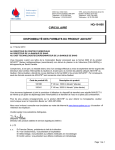
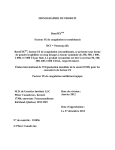
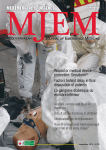

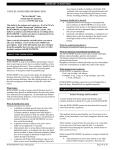
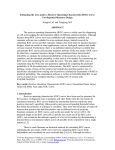
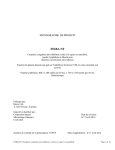
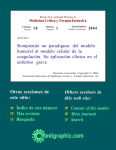
![[Product Monograph Template - Standard]](http://vs1.manualzilla.com/store/data/005786637_1-bbde87d0b5b85ef8c8ff6a7fd943fd08-150x150.png)

